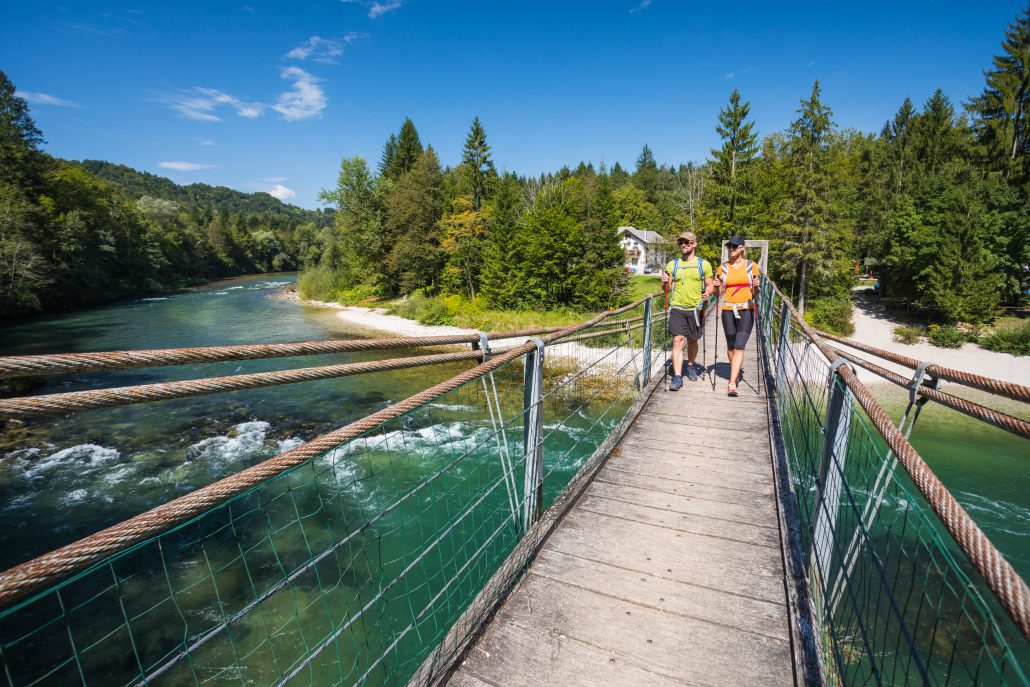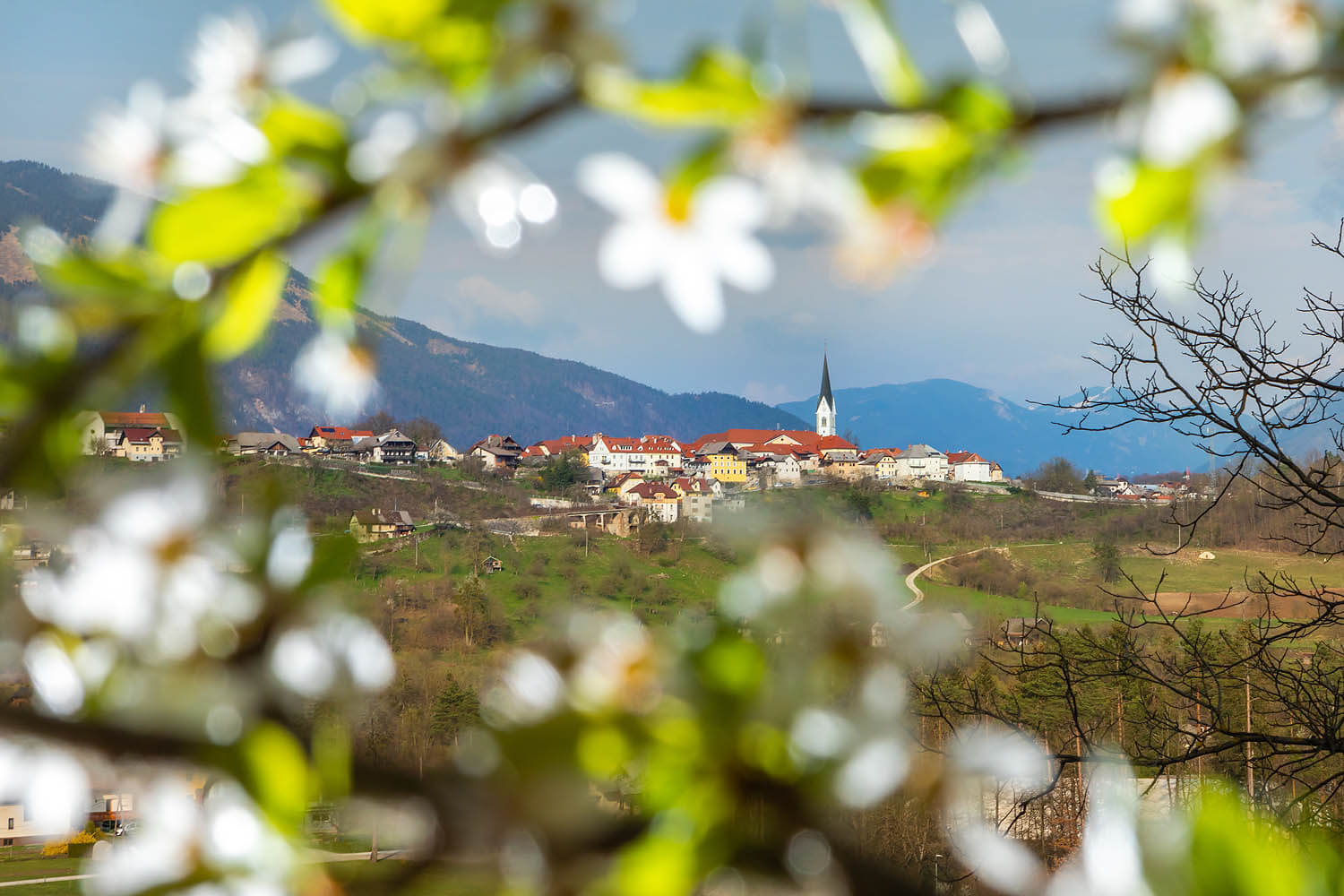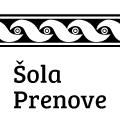Radovljica in the palm of your hand
Take the town in the palm of your hand like the man from Radovljica’s coat-of-arms. Walk from one burgher villa to another. Enter houses of important heritage. Continue your journey along the Sava River.
Start in the town as it used to be
Whichever point in the town you choose, you already find yourself on an interesting route through Radovljica. If you have just arrived to the town, start the tour near the bus station, on Vurnikov trg square. It is named after an important architect whose work you will encounter on your way. At the library, look at the interesting ceramic model (1) of Radovljica, as it was during the period from the 16th to 19th centuries. From the square, head into the street, parallel to the library, and continue straight past the high school to the crossroads with Gorenjska cesta road. Turn into Gorenjska cesta and keep to your left. There are interesting Art Nouveau and historical buildings, such as the Šmajd and Šarec villas (2).
Recommended time for stops: 15 minutes
Discover the symbols in the coat-of-arms
On Gorenjska cesta road, stop for a moment in front of the building of the Regional Chamber of Crafts, where there is a statue of a man from the coat-of-arms of Radovljica (3). He is holding the town in one hand, and a wheel in the other. Next, you can see the famous Čebelica Building (4) with a recognizable bee decoration above the entrance. On the other side of the crossroads is the building of a former savings bank (5) with stucco decoration and the town’s coat-of-arms.
Recommended time for stops: 10 minutes
Welcome the first Slovenian playwright
Between Gorenjska and Kranjska cesta roads, a monument to Anton Tomaž Linhart (6) the first Slovene playwright and co-creator of the Enlightenment in Slovenia, awaits you in a small park. There you can see interesting wrought iron lights (7), created by famous blacksmiths from Kropa in collaboration with renowned designers. Continue past Resman Villa (8) with a beautiful garden to Linhartov trg square with Linhart’s birth house (9). Nearby, where the square widens, is the town fountain, which is also a kind of monument to Josipina Hočevar (10).
A Tip: Opposite Resman Villa is Gostilna Kunstelj inn, which has been famous for its excellent Slovenian cuisine since 1873. Dishes are prepared according to old recipes and with ingredients from the home garden. From the terrace, you can enjoy the views of the Julian Alps.
Recommended time for stops: 10 minutes + time for lunch
Enter the houses of artists and alchemists
On Linhartov trg square, to your right, there is a series of former artisan houses with preserved architecture from the 16th and 17th centuries. Among them, the Šivec House (11) with a gallery is most interesting. There are exhibitions of domestic and foreign artists here. The gallery is also home to a valuable collection of illustrations for children and youth, created by Slovenian illustrators. In the house, you can also see a preserved room, a wreath kitchen and a granary from the 18th century. At the end of the series of artisan houses is the Pharmacy and Museum of Alchemy (12) with interesting objects from all over the world.
A Tip: You feel the pulse of the town when you stop in one of the cafes on Linhartov trg square or in any of the restaurants such as Gostilna Lectar or Gostilna Avguštin. There is also Bistro Linhart, where renowned chef Uroš Štefelin pampers the palate.
Recommended time for stops and sights: Šivic House: 20-70 minutes; Pharmacy Museum: 30 minutes
Head for views and Vurnik's works
If you turn right, you will come to a viewpoint where you can take in the views of the Sava River valley and the Julian Alps. From there you can take the steps back to Linhartov trg square. As you are also interested in the architect Ivan Vurnik (12), turn left beforehand. Gradiška pot path brings you to the old cemetery (13) with two eye-catching works by Vurnik. One of them is also their family tomb. After visiting the cemetery, return to the viewpoint. Just before it, take the steps on the right side of the road to the square with St. Peter’s Church (15), for which Vurnik made the tabernacle. There is also an exhibition on the urban development of Radovljica.
Recommended time for stops: 30 minutes
See the excellent manor and museums
At the beginning of Linhartov trg square, visit the Radovljica manor (16) with a rich staircase, two atriums and special event halls. On the first floor, there are two important museums. The Museum of Apiculture (17) presents the world-famous pioneer of beekeeping Anton Janša, numerous painted beehive panels and the Carniolan honey bee – Slovenia’s autochthonous bee. The Municipal Museum (18) reveals the turbulent period of the Enlightenment and Anton Tomaž Linhart in a permanent exhibition.
Recommended time for a stop: 60 minutes
Walk to the first hotel and a commercial villa
At Lectar House (19) turn right and continue along Trubarjeva ulica street with views of the Karavanke. This takes you to a former Baroque park. Continue under the ancient linden trees and past the National Liberation Front tomb to Grajski dvor (20). The first Radovljica town hotel, built in the years 1934 – 36, was designed by Ivan Vurnik as well. Return along the hornbeam avenue. At the end of it is another of Vurnik’s works – Vila Slavnik (21). The wrought iron image of the god Hermes still reminds us of the once largest store in the city.
Recommended time for a stop: 1 0 minutes
Return through the only defense moat in Slovenia
Cross the roundabout and take the steep road down to the only preserved town defence moat in Slovenia (22). Walk through the moat and then on reaching the other side turn left towards a house that has a statue on the corner of Mary with Jesus. This is the birthhouse of the architect Ivan Vurnik (23). Continue along a dirt track, which leads beneath the walls of the Radovljica park and back towards the start.
Recommended time for stops: 15 minutes
Suggestions for a hike
Take the circular route by the Sava river
From the viewpoint in the old town of Radovljica, take the path along the Sava River, which will take you to the village of Lancovo and back to the town in less than two hours. From the viewpoint, head to the Pusti grad Natural Science Educational Trail. The path through the forest brings you to Fux footbridge across the river. The footbridge, which supposedly existed as early as 1865, provided the shortest pedestrian connection between Radovljica and Kamna Gorica. Cross the river, leave the Natural Science Learning Trail, and turn right onto Pot ob Savi path. Following the old fishing paths and past the picturesque boulders, you will reach the fields in front of the village of Lancovo. Continue to the main road and the bridge across the Sava River. This is the first bridge that crosses the Sava River. Only a few hundred meters upstream is the confluence of the rivers Sava Dolinka and Sava Bohinjka. When you cross the bridge, return to Radovljica and to your starting point at the viewpoint.
More information: TIC Radovljica, Linhartov trg 9, T: 04 531 51 12

1. Model of Radovljica
In front of the entrance to A. T. Linhart Library, there has been a unique model of late medieval old town since 2020. The model is the work of the local master of clay design Urban Magušar. The town depicts walls, defensive towers, town gates and a town moat.
2. Šmajd and Šarec villas
Architect Danilo Fürst, a pupil of the famous Jože Plečnik, designed the villas, built in the years 1939 – 1940. The influences of the famous teacher are also reflected in both villas, which have ornaments made of carved stone, wood and brick. Doctor Janez Šarec had a medical practice in the Šarec Villa before the Second World War. The owner of the Šmajd Villa was the lawyer Albin Schmeid.
Gorenjska cesta 25 in 27
3. Monument of a man from the town’s coat -of -arms
The man holding a stylized town in his left hand and a wheel with six spokes in his right hand was depicted on the seal of the town of Radovljica as early as 1514. There was also an inscription tape with the (German) name of the town on this seal. The coat-of-arms of Radovljica is thus a classic “explanatory” coat-of-arms, uniting RAD (a wheel) – MAN (a man) – STA (D)T (a town). Actually, the name of the town was Radmansdorf, but the people of Radovljica thought they could change it when they got town rights, so it would no longer be village (Dorf), but a town (-STAT).
Gorenjska cesta 20
4. Čebelica building
The Art Nouveau building of the former Loan Bank, built in 1906 according to the plans of the architect Ciril Metod Koch, got its name from the characteristic decoration above the entrance. It depicts a beehive in the form of a straw basket and bees. A special feature of the building is the naturalistic colour decoration made of ceramic tiles. As a modern Art Nouveau decoration, metal was added to it, which Koch used in the balconies, windows and plastics of bees. The Radovljica Administrative Unit now operates in the building.
Gorenjska cesta 18
5. Former savings bank building
The building, built in 1905, is the work of the Czech Art Nouveau builder Josef Hronek. The entrance is accentuated with stucco decoration, in which there is also a man with a wheel from the town’s coat-of-arms. The building, thoroughly renovated in 2017, houses a bank.
Gorenjska cesta 18
6. Monument to Anton Tomaž Linhart
Anton Tomaž Linhart se je rodil 11. decembra 1756 v Radovljici. Dan njegovega rojstva je zdaj občinski praznik. Njegovo delo Poskus zgodovine Kranjske in drugih dežel južnih Slovanov Avstrije (1788, 1791) velja za začetek slovenskega nacionalnega zgodovinopisja. Njegovo dramsko delo Županova Micka (1789) pomeni rojstvo slovenskega gledališča. Linhartu je posvečen bronast spomenik z obliko odra in knjige, v kateri je izrezana znamenita Linhartova podoba. Kip je delo akademskega kiparja Staneta Kolmana in arhitekta Marka Smrekarja.
park between Gorenjska and Kranjska cesta roads
7. Wrought iron street lights
Street lamps are the work of renowned designers and blacksmiths from Kropa. Together with other unique forged products in Radovljica, they create a unique outdoor blacksmithing exhibition. Kropa, a small town near Radovljica, has long been synonymous with Slovenian blacksmithing. After the collapse of ironworks, the masters in Kropa focused on the development of artistic forging. The town, which is worth a visit, it is still home to the largest art forging craft workshop in Slovenia. There are also several independent artistic blacksmiths working here.
park with the Linhart monument and several other locations around the town
8. Resman villa
At the end of the 19th century, an estate here touched the castle park. A high wall surrounded it. The building on the estate was intended for a sheep barn, and maids lived upstairs. In 1918, a leather dealer Janko Resman bought it and rearranged the barn into living quarters.
Gorenjska cesta 8
R9. Anton Tomaž Linhart’s birth house
The birth house of Anton Tomaž Linhart is one of those bourgeois residential buildings that grew into the town walls after gradual abandonment of defensive structures in the 18th and 19th centuries. The first Slovene playwright Anton Tomaž Linhart was born in this house in 1756. The façade boasts a memorial plaque. At the beginning of the 19th century, the façade of the house was decorated with reliefs of painters, musicians, stonemasons and sculptors.
Linhartov trg 10
Josipina's fountain
The fountain with a statue is dedicated to Josipina Hočevar, who donated a house for teachers and a fund for support, and presents for, Radovljica students. In 1906, she donated funds for the construction of the waterworks in Radovljica. As a sign of gratitude, the townspeople erected a fountain in her honour two years later. The fountain is complemented by a statue of a schoolboy leaning on a medallion with Josipina Hočevar’s image, whilst holding a school book in his other hand.
Linhartov trg 20
11. Šivec house
The Šivec House is one of the best examples of late Gothic bourgeois architecture and the best example of a bourgeois house from the 16th century in Slovenia. A 17th-century Creation of Eve fresco, “stitched” corners and window and door decoration adorn the façade. On the ground floor, there is a preserved Gothic vaulted ceiling. On the first floor, there is a representative living room with original wooden panelling, a kitchen and a granary. The permanent exhibition displays the collected works of 27 Slovenian illustrators.
Šivčeva hiša Gallery, phone: 04 532 05 20
12. Pharmacy and museum of alchemy
Alchemical laboratory, old scales , decorated ceramic containers for storage of medicines, mortars (the oldest originates from the 12th century), pharmaceutical books, including the book from the 15th century – this is only a part of what you can see in the single museum, dedicated to pharmacy and alchemy in Slovenia. The museum offers an ethnological collection of folk medicine in Slovenia, and a collection of cosmetics and perfumery associated with family tradition of the museum’s owner. The museum also boasts a shop equipped as an old pharmacy.
Linhartov trg 28, T: 031 744 022
13. Ivan Vurnik
In addition to Jože Plečnik and Max Fabiani, Ivan Vurnik (1884 – 1971) was a pioneer of modern Slovene architecture and the founder of urbanism in Slovenia. He was born in Radovljica, but studied architecture in Vienna. After the First World War, he co-created the Slovene national style, and in the late 1920s and 1930s, he turned to modernism. In Radovljica, where he lived with his wife Helena Kottler Vurnik, a painter, since 1957, he created several important works.
S14. Old cemetery
Two of Vurnik’s works stand out in the old cemetery. The first is the tomb of the Resman Vidic family, which has the shape of a tent pyramid built of stone blocks. A wrought iron net closes its entrance. Next to it is a mausoleum erected by Ivan Vurnik after the Second World War for his son, who died at the age of 19. The architect and his wife are also buried here. The mausoleum has elements of Egyptian architecture. The interior is decorated with mosaics by the architect’s life companion Helena Kottler Vurnik.
Gradiška pot 6
15. St. Peter’s church
The church, which was already in the 13th century seat of the archdiocese, got its present modest appearance at the end of the 19th century. The church has a preserved magnificent gothic hall. Artfully shaped arches, an angelic star, a black marble altar from the 18th century and a white Mary’s altar from the late 19th century, adorn it. At the end of the north nave stands the tabernacle, designed by Ivan Vurnik in the 1930s and decorated with paintings by his wife Helena Vurnik. In the square in front of the church, there is an exhibition on the urban development of the town. There is also a monument to Cene Avguštin, the first Gorenjska museologist and researcher of building development in towns.
Linhartov trg 31
16. Radovljica manor
On the site of today’s manor, the Counts of Ortenburg built a small castle in the 13th century, which was first thoroughly renovated in the middle of the 16th century. Today’s size is the result of the extension in the 17th century, while the exterior architectural appearance dates from the 18th century. The main entrance of tuff is adorned with two men of Atlantis on the sides and the count’s coat-of-arms at the top. Inside is a hall with a rich staircase and a niche in which there was once a fountain. Portals made of green tuff lead into two atriums. On the first floor, there is a Baroque hall and a dance hall.
Linhartov trg 1
17. Museum of apiculture
In the museum, which opened in 1959 and was thoroughly renovated in 2021, you can learn about the importance of Slovenian beekeeping for the whole world. Part of the museum presentation is dedicated to Anton Janša (1734 – 1773), whose birthday, May 20, was declared World Bee Day by the United Nations. Here you can see an exhibition of almost 250 painted beehive panels – the oldest is from 1758. You can also get to know Carniolan honey bee – an autochthonous Slovenian bee. It can be seen in the observation hive in the museum from spring to autumn.
Linhartov trg 1, Museums of Municipality of Radovljica, T: 04 53 20 520
18. Muncipal museum
In the museum, you can feel the time of the 18th century, which was a turning point for the development of Slovenianism and Slovenian theatre. The permanent collection, among other things, tells about the life and work of Anton Tomaž Linhart, an Enlightener and intellectual but, most importantly, Slovene awakener, the first Slovenian playwright, the father of Slovenian theatre and scientific historiography.
Linhartov trg 1, Museums of Municipality of Radovljica, T: 04 53 20 520
19. Gingerbread house
As early as 1766, there was a gingerbread workshop in the renowned inn. Here you can still see how gingerbread (lect) hearts and other honey dough products are made. The inn, which has been operating since 1822, offers traditional Gorenjska and Slovenian dishes.
Linhartov trg 2, T: 04 537 48 00
20. Grajsk i dvor
The mighty hotel building at the end of the former castle park is distinguished by its symmetrical facade with large windows and highlighted shelves and lintels.
Kranjska cesta 2, T: 04 531 55 85
21. Villa Slavnik
The merchant Vinko Savnik built the burgher villa at the entrance to the old town of Radovljica between 1922 and 1925, according to the plans of Ivan Vurnik. The mighty modernist villa was known as the Moda trading house.
Gorenjska cesta 2
22. Town defense moat
Once, a wide and deep moat protected the entrance to the town on the only side that was not protected from the valley. Above the moat was originally a drawbridge. The wooden bridge was replaced in the 18th century by a masonry overpass, under which the path now leads. The town gate was located by the moat, and to the right and left, a double defensive wall, fortified on the southwest and northwest by strong corner towers, connected the entrance to the town. Later, when the defence of the town was no longer needed, houses grew above the moat and next to it.
entrance from Kolodvorska Street
23. Birth house of architect Ivan Vurnik
Janez Vurnik Jr., the father of the architect Ivan Vurnik, who was born in this house, made the statue of Mary with Child in the corner niche of a simple farmhouse. The statue is a copy of the original kept by the National Gallery in Ljubljana. A round mosaic with Christ’s monogram on the entrance portal bear witness that Ivan Vurnik and his wife Helena Kottler Vurnik lived here. Vurnik’s wife Helena, a painter and mosaicist, participated in almost all of the architect’s projects for his church clients.
- 11. Model of Radovljica
- 22. Šmajd and Šarec villas
- 33. Monument of a man from the town’s coat -of -arms
- 44. Čebelica building
- 55. Former savings bank building
- 66. Monument to Anton Tomaž Linhart
- 77. Wrought iron street lights
- 88. Resman villa
- 9R9. Anton Tomaž Linhart’s birth house
- 10Josipina's fountain
- 1111. Šivec house
- 1212. Pharmacy and museum of alchemy
- 1313. Ivan Vurnik
- 14S14. Old cemetery
- 1515. St. Peter’s church
- 1616. Radovljica manor
- 1717. Museum of apiculture
- 1818. Muncipal museum
- 1919. Gingerbread house
- 2020. Grajsk i dvor
- 2121. Villa Slavnik
- 2222. Town defense moat
- 2323. Birth house of architect Ivan Vurnik





